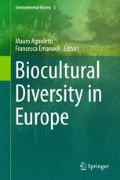Abstract
This work shows and discusses ten years of activities of the Union of Municipalities of Garfagnana to support the protection of local agrarian biodiversity in a sustainable rural development perspective. Such activities were based on the involvement of local community as the main protagonist of the process of development together with the coordination role of local institutions. The key elements of the success of the Garfagnana model was the exploitation of the multifunctionality of local resources and the diversification of local economies, taking into account both local knowledge on agricultural traditions and the contribution of research, as in the case of the white Garfagnina sheep breed attests.
Access this chapter
Tax calculation will be finalised at checkout
Purchases are for personal use only
Notes
- 1.
Ministero delle politiche agricole alimentari e forestali, Italian Ministery of agriculture, food and forestry.
- 2.
The collaboration between the Union of Municipalities of Grafagnana (former Mountain Community) and the Institute of Biometeorology of the National Research Council, IBIMET-CNR, was based on the convergence of objectives toward the development of female enterprises and entrepreneurship through the sustainbale exploitation of tangible and intangible resources of rural areas, in particular, those related to the possible development of “short” textile supply chains. This was the main objective of the project “Percorsi di Orientamento” (2008–2011), financed by the Ministry of Labour and Social Affairs and coordinated by CNR-Ibimet in four Italian regions: Tuscany, Emilia Romagna, Sardinia and Campania.
- 3.
Former “Agenzia Regionale Sviluppo e l'Innovazione nel settore Agricolo” (regional agency for the development and innovation in the agricultural sector).
- 4.
“Guardiania unica” is an ancient practice used by many breeders who leave their animals to a sheperd entrasted to looking after the herd during summer. Sometimes the sheperd looking after the livestock can be one of the breeders confering the sheep. The shepherd is rewarded with a sum of money shared by all the breeders according to the number of animals confered. Once this practice was used also for cattle (summer pastures) and pigs (oak woods) for short periods.
- 5.
Commission Regulation (EU) No 142/2011 of 25 February 2011 implementing Regulation (EC) No 1069/2009 of the European Parliament and of the Council laying down health rules as regards animal by-products and derived products not intended for human consumption and implementing Council Directive 97/78/EC.
References
Altieri MA (1995) Agroecology: the science of sustainable agriculture. In: Agroecology: the science of sustainable agriculture. Westview Press, Boulder
Bacci L, Camilli F, Di Lonardo, Duce P, Vagnoni E, Mauro (2013) Neglected wools: fundamental steps to counteract the loss of potentially valuable materials derived from native sheep breeds. Hindawi Publishing Corporation conference papers in materials science, vol 2013, Article ID 402372, p 7
Benvenuti S, Loddo D, Macchia M (2008) Biodiversità della “seedbank” di fitocenosi spontanee nella coltura del farro (Triticum dicoccum (Schrank) Schübler) in agroecosistemi della Garfagnana (Lucca) Ital J Agron/Riv Agron 1(Suppl):47–57
Berkes F (2007) Community-based conservation in a globalized world. PNAS 104(39):15188–15193
Brooks J, Waylen K, Borgerhoff Mulder M (2013) Assessing community-based conservation project: a systematic review and multilevel analysis of attitudinal, behavioral, ecological and economic outcomes. Environ Evid 2:2
Brown K, Mackensen J, Rosendo S, Viswanathan K, Cimarrusti L, Fernando K, Morsello C, Muchagata M, Siason IM, Singh S, et al (2005) Ecosystems and human well-being: policy responses. In: Millennium Ecosystem Assessment. Island Press, Washington, DC, pp 425–465
Capistrano D, Samper C, Lee MJ, Raudsepp-Hearne C (2005) Ecosystems and human well-being, vol 4. In: Millennium Ecosystem Assessment. Island Press, Washington
De Stefani C (1878) Delle proprietà comuni e dei limiti alle proprietà private in alcune parti dell’Appennino. In: Storia dei Comuni di Garfagnana. Riv. europea, IX, Modena, pp 115–126
Di Fabio A, Palazzeschi L, Camilli F, Raschi A (2011) Interventi psicologici a sostegno dell’imprenditoria femminile: evidenze empiriche di efficacia nel contesto italiano (Psychological interventions to support entrepreneurship of women: Empirical evidence of effectiveness in the Italian context). Risorsa uomo 4:455–470
Frankel OH, Brown AHD, Burdon JJ (1995) The conservation of plant biodiversity. Cambridge University Press, Cambridge
Gadgil M, Berkes F, Folke C (1993) Indigenous knowledge for biodiversity conservation. Ambio, Biodiv Ecol Econ Policy 22(2–3):151–156
Reid WV, Berkes F, Wilbanks T, Capistrano D (eds) (2006) Bridging scales and knowledge systems. In: Millennium Ecosystem Assessment. Island Press, Washington, DC
Salafsky N, Wollenberg E (2000) Linking livelihoods and conservation: a conceptual framework and scale for assessing the integration of human needs and biodiversity. World Dev 28:1421–1438
Scialabba NE-H (2003) Organic agriculture: the challenge of sustaining food production while enhancing biodiversity. Secretary Priority Area for Inter-Disciplinary Action on Organic Agriculture, Food and Agriculture Organization of the United Nations, Rome, Italy. United Nations Thematic Group, Sub-Group Meeting on Wildlife, Biodiversity and Organic Agriculture, Ankara, Turkey
Turchi B, Nuvoloni R, Fratini F, Pedonese F, Ebani VV, Cerri D (2011) Caciotta della Garfagnana cheese: selection and evaluation of autochthonous mesophilic lactic acid bacteria as starter cultures. J Anim Sci
Author information
Authors and Affiliations
Corresponding author
Editor information
Editors and Affiliations
Rights and permissions
Copyright information
© 2016 Springer International Publishing Switzerland
About this chapter
Cite this chapter
Camilli, F., Pieroni, S. (2016). The Garfagnana Model for Exploiting Agrarian and Cultural Biodiversity: The White Garfagnina Sheep Breed, a Case Study of Sustainable Local Development. In: Agnoletti, M., Emanueli, F. (eds) Biocultural Diversity in Europe. Environmental History, vol 5. Springer, Cham. https://doi.org/10.1007/978-3-319-26315-1_17
Download citation
DOI: https://doi.org/10.1007/978-3-319-26315-1_17
Published:
Publisher Name: Springer, Cham
Print ISBN: 978-3-319-26313-7
Online ISBN: 978-3-319-26315-1
eBook Packages: Earth and Environmental ScienceEarth and Environmental Science (R0)

